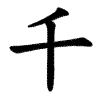千
| ||||||||
Translingual
| Stroke order | |||
|---|---|---|---|
 | |||
| Stroke order | |||
|---|---|---|---|
Han character
千 (radical 24, 十+1, 3 strokes, cangjie input 竹十 (HJ), four-corner 20400, composition ⿱丿十)
Descendants
References
- KangXi: page 155, character 19
- Dai Kanwa Jiten: character 2697
- Dae Jaweon: page 351, character 2
- Hanyu Da Zidian: volume 1, page 59, character 1
- Unihan data for U+5343
Chinese
Glyph origin
| Historical forms of the character 千 | ||||
|---|---|---|---|---|
| Shang | Western Zhou | Warring States | Shuowen Jiezi (compiled in Han) | Liushutong (compiled in Ming) |
| Oracle bone script | Bronze inscriptions | Chu Slip and silk script | Small seal script | Transcribed ancient scripts |
 |
 |
 |
 |
 |
| Characters in the same phonetic series (人) (Zhengzhang, 2003) | |
|---|---|
| Old Chinese | |
| 千 | *sn̥ʰiːn |
| 仟 | *sn̥ʰiːn |
| 芊 | *sn̥ʰiːn, *sn̥ʰiːns |
| 阡 | *sn̥ʰiːn |
| 汘 | *sn̥ʰiːn |
| 迁 | *sn̥ʰiːn |
| 杄 | *sn̥ʰiːn |
| 人 | *njin |
| 仁 | *njin |
| 朲 | *njin |
| 佞 | *neːŋs |
Phono-semantic compound (形聲, OC *sn̥ʰiːn) : semantic 一 (“one, signifying a number”) + phonetic 人 (OC *njin). The Old Chinese pronunciations of 千 (OC *sn̥ʰiːn) and 人 (OC *njin) were similar. For the component 人, compare its combining form 亻.
The traditional explanation holds that the extra line indicates an extension (see the etymologies of 年 and 延). 千 has the meaning one thousand because one thousand is a number that is reached by extending one's counting.
Etymology 1
| simp. and trad. |
千 | |
|---|---|---|
| variant forms | 仟 financial | |
Unknown. Schuessler (2007) noticed similar-looking Mon-Khmer lexical items, though their initials and finals do not match Old Chinese; compare Vietnamese nghìn and Old Mon lṅim (whence Mon လ္ၚီ (ŋìm)), all meaning "thousand". Compare also Proto-Hlai *C-ŋin.
Pronunciation
See also
| Chinese numbers | ||||||||||||||||
|---|---|---|---|---|---|---|---|---|---|---|---|---|---|---|---|---|
| 0 | 1 | 2 | 3 | 4 | 5 | 6 | 7 | 8 | 9 | 10 | 102 | 103 | 104 | 108 | 1012 | |
| Normal (小寫/小写) |
〇 | 一 | 二 | 三 | 四 | 五 | 六 | 七 | 八 | 九 | 十 | 百 | 千 | 萬/万 | 億/亿 | 兆 (Taiwan) 萬億/万亿 (Mainland China) |
| Financial (大寫/大写) |
零 | 壹 | 貳/贰 | 參/叁 | 肆 | 伍 | 陸/陆 | 柒 | 捌 | 玖 | 拾 | 佰 | 仟 | |||
Compounds
|
|
|
Etymology 2
| For pronunciation and definitions of 千 – see 韆. (This character, 千, is the simplified form of 韆.) |
Notes:
|
Further reading
- “Entry #188”, in 臺灣閩南語常用詞辭典 [Dictionary of Frequently-Used Taiwan Minnan] (in Chinese and Min Nan), Ministry of Education, R.O.C., 2011.